
Clients often ask me about conventional “tear-out” remediation. While I believe that there are times and places for traditional demolition methods, I am disappointed by how often tear-out remediation is the first resort.
Consider a typical example. Imagine a flooded basement, in which one must resort to some level of demolition and restoration. Even in this extreme example, the tear-out process has its limitations. Let’s go through, step by step, and discuss what a traditional mold remediation company would do in the case of a basement flood:
- They cut off the water supply or otherwise eliminate the water problem immediately.
- They contain the area, in this case, the basement bedroom. Containment may require using plastic and duct tape.
- They set up a negative air system to keep all mold spores within the bedroom. Think of pulling air into the bedroom, as opposed to blowing throughout the home.
- With a containment system now in place, they may put filters in the area, plus fans and heaters to dry out all wet items, including walls, carpets, etc.
- Next, they will tear out whatever is deemed useless or damaged beyond repair.
- All moldy items get bagged in a plastic bag and hauled outside.
- Once they removed all necessary items, they may or may not spray a fungicide as a wet mist on all affected areas.
- Now, with containment still intact, they may rebuild elements of the basement deemed unrepairable.
- After they complete the rebuild, and with containment still intact, they will run air scrubbers for a few days in an attempt to remove all spores, hyphae, etc., within a contained area.
- Between 10 to 30 days on average after the initial flood, they may or may not run an air quality test within the plastic containment area.
- At this point, they pull down the plastic, remove all of the equipment, and report the project as complete.
I hope that as I detailed these steps, you noticed the obvious “chink in the armor.” Let’s back up to pre-flood house history and discuss.
Let’s assume this house is 15 to 20 years old. As homes age, the “mold load” within a home increases. It has to increase. Every home, regardless of the level of housekeeping, has little pockets of mold growth. You will find these on bathroom tile, bathroom flooring, windows and window sills, on the carpet near water, on clothing, in sink and floor drains, on rags, etc. All of these small areas have mold growth to some degree.
Without a doubt, these little areas will spore and either:
- Add more mold to these areas, or
- Find a new pocket of the home to inhabit.
Remember, mold remains viable for years and years. All of these little pockets cumulate into a higher mold load within a home as the years pass by.
You may know it from the distinctive “grandma and grandpa” smell in an older home. You are smelling elevated levels of mold, which have found hidden homes over the decades.
Various changes in building codes, materials, and styles have made the problem worse. Let’s now assume that on a scale of 1-20, and 20 being an absolute disaster with visible mold, elevated mold spore counts, and mold odor. The very same home the week before the flood was an eight (because the EPA says that up to fifty percent of all homes and buildings are affected by elevated mold levels, eight feels like an appropriate estimation). Within twenty-four hours of the flood, that eight climbed to a fourteen. When the disaster company came in and did their work over the next two weeks on only the basement bedroom, the house may have dropped to a 10 – a higher level than where the home began!
You see, the mold that grew in the basement because of the flood didn’t remain isolated in the basement while you waited for help to come. The mold created during the early stages of the flood undoubtedly sent spores throughout the home. Even if the disaster company removed every single solitary spore, hyphae, and mycelium in the basement, the house still increased in its overall mold load due to the elevated humidity during the flood, the actions taken during the initial cleanup, and the general cleanup. As thorough as the disaster company may have been, I am skeptical that double bagging with a twisty tie prevents rogue mold spores from escaping and seeking refuge elsewhere within the home.
Of most concern to me is that the disaster company may now declare the home to be “safe,” and the customer will assume that their abode is healthy.
In conclusion, what is missing with traditional remediation techniques? Conventional remediation companies fail to recognize that an isolated incident impacts the health of the entire home. The flood did not introduce the mold; the mold was already in the house before the flood. The mold spores found the moisture, grew and spread. The fact of the matter is, the disaster likely just elevated an already moldy home. Again, the EPA now says up to fifty percent of households have moisture problems and elevated mold. The flood exacerbated the issue.
Pure Maintenance is the first mold remediation company in the nation to understand how mold behaves and consider a building as a whole, not piecemeal. Water doesn’t introduce new mold; instead, it accelerates existing mold growth and reproduction throughout a building. Localized rebuilds do not address the entire home’s health; they solve the crisis and conceal the more significant issue. Pure Maintenance, on the other hand, is more affordable and effective. Give us a call today!
This blog was first published on the Pure Maintenance Corporate Website on 14 August 2020 and has been edited for clarity and length by Pure Maintenance Golden State.
